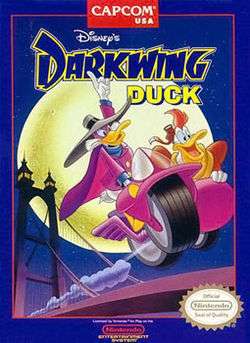Darkwing Duck (Capcom)
| Darkwing Duck | |
|---|---|
|
NES boxart | |
| Developer(s) | Capcom |
| Publisher(s) | Capcom |
| Producer(s) | Tokuro Fujiwara |
| Composer(s) | Yasuaki Fujita |
| Platform(s) |
Nintendo Entertainment System Game Boy |
| Release date(s) |
NES Game Boy
|
| Genre(s) | Action |
| Mode(s) | Single-player |
Darkwing Duck is a platformer video game based on the Disney television series Darkwing Duck. The game was developed by Capcom for the NES in 1992[1] and was ported to the Game Boy in 1993.[2] The Game Boy version is essentially a slightly stripped-down version of the game.
Plot
A mysterious crime wave has hit St. Canard and S.H.U.S.H. requires the services of the caped crime fighter Darkwing Duck to stop it as it appears that F.O.W.L. and their valued operative Steelbeak is behind the uprising. They have hired six of Darkwing's greatest foes to wreak havok in different areas throughout St. Canard. Darkwing must subdue each of these criminals in order to find Steelbeak and save the city.
Gameplay
Darkwing Duck is a platformer with a couple of elements similar to Capcom's Mega Man video game series. The gameplay is based on typical platforming while using a Gas Gun to take down enemies. The player may choose from three different stages at the start of the game with another set of three becoming available after that. Once all six stages are clear, Darkwing proceeds to F.O.W.L.'s Floating Fortress for his final confrontation with Steel Beak.[3] It is said that the game itself is actually running on a tweaked Mega Man 5 engine.
Darkwing begins with his standard Gas Gun but can collect different types of gas throughout each stage: Thunder, Heavy, and Arrow. Each special gas requires having ammunition and take up different amounts and function differently, but the player can only have one type of special gas at a time. Picking up a different type of special gas replaces the one Darkwing currently has. The player can freely switch between the special gas and the standard gas by hitting Select. Darkwing can also deflect certain projectiles with his cape by hitting Up on the control pad.

Development
For the most part the beta version of this game is pretty consistent with the final version. But a few details are different, especially in later levels of the game. At the tower level boss battle, Moliarty lacks a stationary sprite, plus all three flamethrower machines are fully operational when the battle begins. The warehouse wharf level had platforms with spikes under them. At the wharf's boss battle, Megavolt moves much faster and the running spark at the bottom of the screen is not present. The woods level featured owls instead of hawks. In the final boss battle, the pulsating lights over Steelbeak's balcony window are missing. The continue screen features Darkwing standing in center with his arms crossed. He leaps off screen when the player chooses to continue instead of the Thunderquack flying by. When a boss is defeated, Darkwing will leap off screen in tradition to Mega Man teleporting off screen after a battle. In the bonus games, J. Gander states that F.O.W.L. is behind the burglaries. The designs of both bonus games is drastically different. Part one features the entrance to an underground cavern instead of a city rooftop. Part two takes place outside and shows what appears to be a Ferris wheel instead of taking place underground. After the player defeats Steelbeak, Steelbeak doesn't appear on the computer monitor having the last word. The game's final scene in which Darkwing rides into the night is depicted with darker colors.
Unlicensed ports
The game was unofficially ported to the GameKing handheld under the title "Duck Man". Some Russian people from the "New Game" company ported the game to Sega Genesis. A hacked version called Rockman 5 changes Darkwing Duck to an orange version of Megaman.
Reception
| Reception | |||||||||||
|---|---|---|---|---|---|---|---|---|---|---|---|
| |||||||||||
| |||||||||||
The game has been considered an example of the quality Disney games produced by Capcom.[6] It has been noted that the game was intended for children, but became popular with older teens.[7] Author Andy Slaven used it as an example of a game that, while made for children, appealed to teenagers more.[8]
See also
References
- ↑ Search:. "Darkwing Duck Release Information for NES". GameFAQs. Retrieved 2010-09-13.
- ↑ Search:. "Darkwing Duck Release Information for Game Boy". GameFAQs. Retrieved 2010-09-13.
- ↑ Justin Ridenour (September 13, 2000). "GameFAQs: Disney's Darkwing Duck (NES) FAQ/Walkthrough by Rolent X". GameFAQs. Retrieved October 22, 2014.
- ↑ "Darkwing Duck - GameRankings (GB)". Retrieved November 12, 2015.
- ↑ "Nintendo Power Awards" (46). March 1993: 99. Retrieved November 12, 2015.
- ↑ Steven A. Schwartz, Janet Schwartz (1994). The Parent's Guide to Video Games.
Over the last few years, Capcom has produced a brilliant series of games based on Disney characters. Examples include Chip n Dale Rescue Rangers, DuckTales, and Darkwing Duck. Most of the Disney arcade games offer stunning graphics and animation, low levels of violence, and are delightful to play.
- ↑ Andy Slaven. Video Game Bible, 1985-2002.
- ↑ Video Game Bible, 1985-2002 - Google Books. 2004-01-16. Retrieved 2010-10-19.
